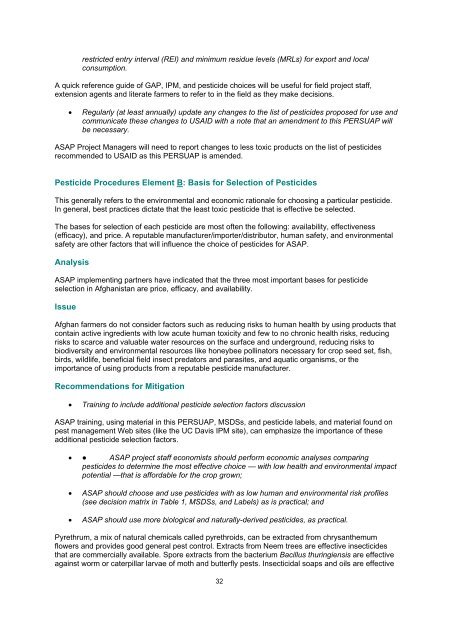Afghanistan Accelerating Sustainable Agriculture ... - part - usaid
Afghanistan Accelerating Sustainable Agriculture ... - part - usaid
Afghanistan Accelerating Sustainable Agriculture ... - part - usaid
You also want an ePaper? Increase the reach of your titles
YUMPU automatically turns print PDFs into web optimized ePapers that Google loves.
estricted entry interval (REI) and minimum residue levels (MRLs) for export and local<br />
consumption.<br />
A quick reference guide of GAP, IPM, and pesticide choices will be useful for field project staff,<br />
extension agents and literate farmers to refer to in the field as they make decisions.<br />
• Regularly (at least annually) update any changes to the list of pesticides proposed for use and<br />
communicate these changes to USAID with a note that an amendment to this PERSUAP will<br />
be necessary.<br />
ASAP Project Managers will need to report changes to less toxic products on the list of pesticides<br />
recommended to USAID as this PERSUAP is amended.<br />
Pesticide Procedures Element B: Basis for Selection of Pesticides<br />
This generally refers to the environmental and economic rationale for choosing a <strong>part</strong>icular pesticide.<br />
In general, best practices dictate that the least toxic pesticide that is effective be selected.<br />
The bases for selection of each pesticide are most often the following: availability, effectiveness<br />
(efficacy), and price. A reputable manufacturer/importer/distributor, human safety, and environmental<br />
safety are other factors that will influence the choice of pesticides for ASAP.<br />
Analysis<br />
ASAP implementing <strong>part</strong>ners have indicated that the three most important bases for pesticide<br />
selection in <strong>Afghanistan</strong> are price, efficacy, and availability.<br />
Issue<br />
Afghan farmers do not consider factors such as reducing risks to human health by using products that<br />
contain active ingredients with low acute human toxicity and few to no chronic health risks, reducing<br />
risks to scarce and valuable water resources on the surface and underground, reducing risks to<br />
biodiversity and environmental resources like honeybee pollinators necessary for crop seed set, fish,<br />
birds, wildlife, beneficial field insect predators and parasites, and aquatic organisms, or the<br />
importance of using products from a reputable pesticide manufacturer.<br />
Recommendations for Mitigation<br />
• Training to include additional pesticide selection factors discussion<br />
ASAP training, using material in this PERSUAP, MSDSs, and pesticide labels, and material found on<br />
pest management Web sites (like the UC Davis IPM site), can emphasize the importance of these<br />
additional pesticide selection factors.<br />
• ● ASAP project staff economists should perform economic analyses comparing<br />
pesticides to determine the most effective choice — with low health and environmental impact<br />
potential —that is affordable for the crop grown;<br />
• ASAP should choose and use pesticides with as low human and environmental risk profiles<br />
(see decision matrix in Table 1, MSDSs, and Labels) as is practical; and<br />
• ASAP should use more biological and naturally-derived pesticides, as practical.<br />
Pyrethrum, a mix of natural chemicals called pyrethroids, can be extracted from chrysanthemum<br />
flowers and provides good general pest control. Extracts from Neem trees are effective insecticides<br />
that are commercially available. Spore extracts from the bacterium Bacillus thuringiensis are effective<br />
against worm or caterpillar larvae of moth and butterfly pests. Insecticidal soaps and oils are effective<br />
32

















